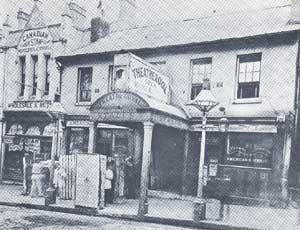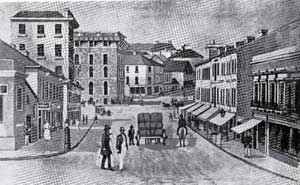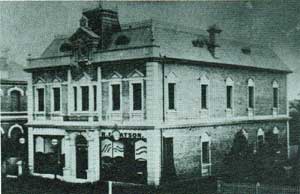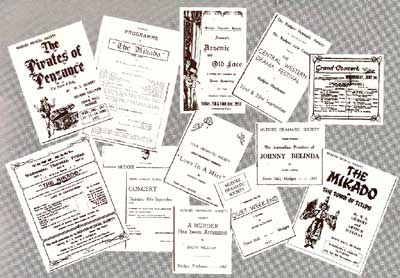Tales From Along the Wallaby Track No. 1077, Monday May 10, 2010
 Live theatre is still alive in Australia’s major cities and in some country towns. This was once the case in Mudgee when there were many active performers and groups.
Live theatre is still alive in Australia’s major cities and in some country towns. This was once the case in Mudgee when there were many active performers and groups.
The theatre is a world full of dreamers and their dreams. The real magic in a theatre is the moment the houselights dim, the audience is silent, the curtain rises and the show begins.
It is wrote the inventor Sir Henry Bessemer (1813-1898), an old man’s privilege to look upon the past and compare it with the present. It is no less a privilege to do so when his thoughts turn to those subjects in which he himself has taken a more or less conspicuous part.

Australian theatre history incorporates the stories of many actors, entrepreneurs, playwrights, directors and others working behind the scenes and on stage across the country. Countless performances have entertained, enchanted, bored, captivated and confronted Australian audiences. There have been amateur and professional groups, local performers and artists visiting from other countries, lavish large scale productions and small community-based shows featuring plays and performances written by Australians and those imported from other countries.
First playwright
David Burn has been called Australia’s first playwright. He was a cultured young Scot who had moved to London in literary circles before spending some time in the navy. He arrived in Tasmania in 1825. By 1829 his first play The Bushrangers was produced, not in Australia, but at the Caledonian Theatre, Edinburgh.
Burn had literary pretensions and wrote a number of stilted verse tragedies. These were published in Hobart in 1842. There is a manuscript copy of this play in the Mitchell Library, Sydney. Burn’s Plays and Fugitive Pieces in Verse was the first collection of dramatic works published in Australia.
First performance
The first dramatic performance in Australia (Aboriginal corroborees excepted) took place on June 4, 1789, King George III’s birthday. It was George Farquhar’s comedy The Recruiting Officer. It was performed by 11 convicts “in a mud hut fitted out for the occasion”. The account of the performance taking place comes from Captain Watkin Tench in his Complete Account of the Settlement at Port Jackson.
Tench also describes how coloured paper was used to decorate the place. Farthing dips and sperm whale flares lit the customers to their seats, and a few oil lamps were the footlights. Admittance was in kind. Rum, tobacco, wine, poultry, corn and wheat valued at £20 sterling were taken at the door.
Governor Arthur Phillip and his officers were among the 60 people who attended. This was a far cry from Wicked a masterpiece in technology currently playing in Sydney.
Actors
From then on actors and promoters appeared and disappeared. The disordered fun of early colonial drama did not match the idea of Australia as a penal colony, a place of punishment for convicts. Some authorities believed theatre to be a bad influence, others felt it was useful entertainment and these views affected the way theatre developed in the colony.

The authorities struggled with issues such as badly-behaved theatre audiences, theatre licences and crime.
Robert Sidaway opened a theatre on January 16, 1796 managed by John Sparrow. It was known simply as the Theatre. It had prices in four divisions in its auditorium, pit, front boxes and gallery. It is not known whether Sidaway’s theatre was near the bakery where he made the colony’s bread, east of Bell Row, now Bligh Street or near his home off High Street (now George Street) near Jamieson Street.
The theatre’s existence was chequered. Goods in kind were accepted in place of the one to five shillings charged for admission. One report claims that while the mostly convicts and emancipists were at the theatre their homes were ransacked by other convicts.
Robert Sidaway was followed by Barnett Levey who established Sydney’s Theatre Royal in 1833 and Lola Montez, George Coppin, Mr and Mrs Charles Kean and many others.
In the late 1820s and early 1830s vacant land fronting the southern side of Hunter Street between “China” Jones’ mansion and George Street was a favourite rendezvous of showmen and entertainers, who pitched their tents on the spot.
The main factor which transformed Australian theatre from a struggling, semi-amateur affair into a fully fledged profession was the gold rushes of the 1850s. They brought a growth in population and increased trade and wealth from the goldfields. There was a growing demand for theatre entertainment, and Shakespeare and opera performances increased. Touring companies such as the New York Serenaders and the Backus Minstrels brought minstrel shows to Australia from California.
In the early years of 1900 few people could have foretold the theatrical boom was about to end. But the signs were there in the form of the first primitive film shows.
World Wars
During and after World War I public taste led to greater predominance of light musical shows. Gladys Moncrieff, Dorothy Brunton, Madge Elliott and Strella Wilson emerged as “stars”. They performed in musicals such as Rose Marie, The Desert Song, Collit’s Inn and White Horse Inn.
The years of the Great Depression in the early thirties closed many theatres. Actors found little work within the profession.
In 1937 Fay Compton toured in Victoria Regina and a number of Noel Coward plays whilst J. C. Williamson continued to present revivals of the Gilbert and Sullivan Savoy operas. The outbreak of World War II in September 1939 made it impracticable to import companies, or even individual actors.
The most stimulating event of the post-war period was a tour in 1948 by the Old Vic Company, led by Sir Laurence Olivier and his then wife Vivien Leigh. Their visit was the turning point and the professional, “Little Theatres” and amateur theatres boomed until the advent of television.
Mudgee
On June 11, 1860 the Council applied for a grant of land from the Government between Market, Short, Perry and Douro Streets for the purpose of erecting a Town Hall, but nothing came of it.

Some 20 years later in April 1880 tenders were considered for the foundation only or complete work of a Town Hall and theatre. Aula and Jackson’s tender of £2966 was accepted. However they failed to sign the necessary contract papers and the contract was eventually taken over by Messrs. McFarlane and Henry.
The Town Hall and theatre was opened on December 15, 1881 and the first concert held in the new Town Hall was given on March 17, 1882 by the public school teachers and children. Entry to the theatre at that time was through the main door of the building and then by use of internal stairs.
Since then many performances have graced the stage of the theatre by local and visiting companies. In April 1967 the Mudgee Guardian printed letters from citizens alarmed at Council’s proposal to convert the theatre into more palatial accommodation for the aldermen and the fact there was no alternative for theatrical presentations. The people won the battle.
On four nights in October 1983 a variety concert was held to celebrate the opening of the last major renovations to the theatre. Since then dressing rooms, toilets and a foyer have been added. At present the Town Hall Theatre is in a sorry state once again. Parts of the inside fabric is riddled with white ants or dry rot, cracks appear in the walls, the traverse curtain is water-stained and torn. Water pours in every time it rains and pigeons have taken residence.

At the time of writing this column unlike its counterpart in 1967 the present Council is silent on the restoration work necessary for this heritage listed building. Why the silence?
If the present Council is contemplating the demise or another use for the theatre perhaps it is timely to remind Council of the old theatrical saying—nothing is over “until the fat lady sings”.

You must be logged in to post a comment.